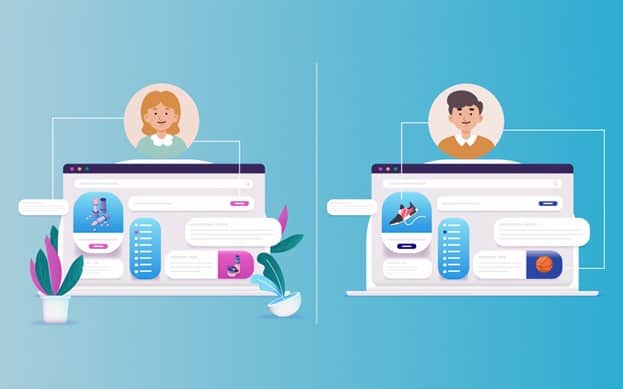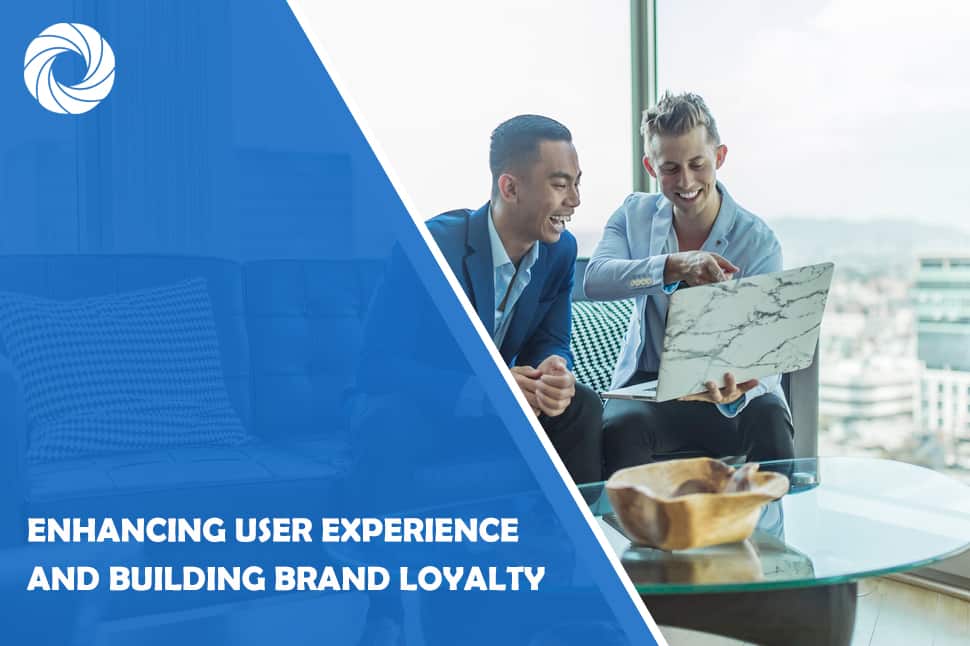There's no denying that we're drawn to beauty and uniqueness. When we stumble upon something that's truly extraordinary and stands out from the rest, we can't help but be intrigued. Business owners and savvy marketers alike are well aware of this peculiar human trait, and they know how to make it benefit them. They understand the power of tailoring products to individual needs, particularly when it comes to web platforms.
Think about it: when you land on a website that seems tailor-made for you, with content that aligns perfectly with your interests and aesthetic preferences, you're likely to stick around for a while. And if you find yourself coming back to that site time and time again, it's a sure sign that they've nailed it.
So if you're looking to create a web platform that truly resonates with your audience, it's crucial to take a personalized approach. By tapping into your users' behavior and preferences, you can create a more engaging, relevant experience that will keep them coming back for more. It's a zero-risk undertaking: your users get exactly what they're looking for, and you get to build a loyal following of engaged, satisfied customers.

The benefits of website personalization
Imagine having a magic wand that transforms your web platform into a personalized haven, tailored to meet the unique needs and interests of each and every user. This is the power and role of website personalization – a built-in mechanism that gradually learns and adapts to visitors’ preferences using the magic of machine learning.
Users are given personalized content and offers as they move around your website, making their web experience unique and ensuring their loyalty. The benefits of website personalization are many and varied, and here are just a few:
-
Building a loyal audience
Crafting a personal touch can be very effective in luring and maintaining clients. If companies provide content that speaks to people on a personal level, they can form a dedicated customer base that will return over and over.
-
Enhancing engagement
Offering content with an individual in mind can result in increased engagement, as users are more likely to stay longer, become involved with what you offer, and establish a strong connection with your brand.
-
Influencing conversion rates
Making websites more personal can also drive up conversion rates. By giving the audience useful and up-to-date information, businesses can increase the chance of users doing something like purchasing a product or signing up for a newsletter.
-
Shaping customer satisfaction
If a company recognizes users' needs and preferences and tries to consider them when building a site, this leads to greater customer satisfaction. Users feel special, cherished, and needed. And this pleasant feeling works for the benefit of the company as well.
-
Improving marketing effectiveness
By collecting data and analyzing it, companies can customize their content and offers, which leads to higher engagement and better conversion rates.
-
Gaining insights into the preferences of the clientele
Customization boosts the user experience, as well as grants businesses the opportunity to gain a better insight into their customers. Examining customer behavior through data analysis can provide businesses with invaluable information regarding what customers prefer and expect. Utilizing this information can help to optimize products, services, and marketing approaches so they are more catered to customer demands. Among the benefits of website personalization, this one is essential: it helps businesses grow and perfect themselves.
Overall, web personalization is a vital ingredient in creating a beautiful, engaging, and successful online presence. If you're looking to bring your website up a notch, implement this strategy and benefit from remarkable results.
For companies wanting to give a unique user experience and increase brand loyalty, web personalization is no longer just an extra perk. It's quickly becoming an indispensable part of the tech-driven world we live in. The principle is commonly known, yet many businesses still have difficulty with its execution.
Luckily, many companies have effectively used customization strategies and reaped the benefits, including greater user engagement, higher conversion rates, and improved brand perception. Let's delve into some cases, discovering how these brands have effectively implemented this approach, and the tangible results they've seen.
Andersen: personalizing the website for different regions
Andersen is a successful IT provider with a proven track record and 16+ years of experience. The scope of its offerings is vast: eCommerce web development services, mobile, custom, and cross-platform development, UX/UI design, QA, and many more. As the business is constantly growing, so is its audience. The company has already gained a worldwide clientele. As a result, it became necessary to personalize the site for different audiences.
The most obvious variation is the language tailoring. It's worth mentioning that 72.1% of customers primarily or solely use sites in their native tongue. Therefore, Andersen’s move is sound and reasonable. One of the largest regions the company works with is DACH, so there is a separate website in German. Not only landing pages but also articles from the blog are available in it. The company has tried to do extensive work in this direction and provide German-speaking visitors with the content that fully meets their needs.
But even the same language version differs depending on the location of a user. For example, clients from the USA and Great Britain see some pages or page elements differently (see the map in the infographic below).
By implementing region-based versions, Andersen’s professionals aim at making customers’ web experience much more convenient and relevant. In fact, regional personalization is what most leading companies across industries are striving to carry out. So, this international software provider has chosen the proven way to create an aesthetically pleasing yet highly personalized site.
Spotify: suggesting relevant music and playlists
Spotify is one of the best-loved music streaming platforms worldwide. The company has already attracted legions of happy users who admire its vast library and huge customization potential. Indeed, this platform can serve as a paragon for those willing to build streaming solutions of any kind.
When it comes to music or video, it’s all about individual preferences. Of course, music lovers will find their favorite artists and albums anyway. But with individualized hints, they can come across exciting new artists they have never heard of. For example, if you are a fan of classic rock bands like the Beatles, Queen, Pink Floyd, and so on, be sure that the Doors or Led Zeppelin will emerge as suggestions pretty soon.
Imagine having a soundtrack perfectly tailored to your mood, activity, and occasion. That's the magic of Spotify's personalization, and it's an experience that the company is proud to provide. Listeners no longer need to spend hours crafting the perfect playlist for their dinner party or road trip. Instead, they can sit back, relax, and let the algorithm do the heavy lifting.
But it's not just about convenience. It's about discovery. Users benefit from curated playlists and recommendations – these help subscribers make hundreds of artist discoveries annually. It's like having a musical genie at your fingertips, constantly introducing you to new and exciting sounds.
The ultimate goal is to create a better app experience. By ensuring that users are always presented with content that they love, the platform keeps them interested in listening to music even more. Spotify thus provides a “fulfilling content diet” that balances new discoveries with old favorites, so that people can enjoy the app without feeling overwhelmed or burnt out.
Netflix: meeting users’ taste with exciting movies
Each subscriber has their own personalized Netflix, tailored to their unique preferences and interests. That's a fundamental pillar of what makes this pioneering VOD and streaming platform so great. By leveraging a multitude of algorithmic approaches, the company creates a custom experience for each and every one of its users, no matter how diverse their tastes may be.
When you log into Netflix, you're not just getting one product – you're getting hundreds of millions of videos, each one customized just for you. Smart algorithms are constantly analyzing your viewing behavior and interests to suggest videos that you might love. But it doesn't stop there. Top-notch developers have implemented an efficient mechanism of organizing, ranking, and displaying videos, creating an experience that is unique to your profile.
And it's not just about what you see on the homepage. The company uses personalization to improve every aspect of the Netflix experience, from search to messaging. Its sophisticated search capability allows you to find the perfect video, no matter what language or device you're using. And Netflix’s employees are always experimenting with new ways to make personalization even better, through offline experiments and online A/B testing.
At the end of the day, the company's goal is simple: to help you find something great to watch faster. Professionals working here know perfectly that consumers don't want to spend hours scrolling through options – they simply want to dive right into a movie or TV show that they truly love. And that's what the customized approach they are implementing is all about: creating an experience that's as unique and varied as the members themselves.
Amazon: the king of eCommerce personalization
Our list would be incomplete without Amazon. This eCommerce giant has revolutionized the way we shop online, and its web personalization strategy is a key part of success.
Amazon knows its clientele inside out and uses this knowledge to create an individual experience that's meant for each customer. From the moment you log in, you'll see a homepage that's full of individualized suggestions and hints.
But the company’s strategy goes far beyond just using your name and address. Smart algorithms track your browsing and purchase history, as well as your search queries, to build a detailed profile of your interests and preferences. This information is then used to suggest products and content that you're likely to be interested in.
One of the ways that Amazon does this is through their recommendation engine. This powerful algorithm analyzes your behavior on the site, as well as the behavior of other people with similar interests, to suggest products that you might like. They also use collaborative filtering, which looks at the behavior of other users who have purchased similar products to you, to suggest related items.
But Amazon's personalization strategy isn't just about recommending products. They also use it to enhance the overall UX. For instance, the design and layout of the site are adapted to your device and browser preferences for a smooth experience.
And Amazon doesn't stop at its website. They also use personalization in their marketing and communication strategies, sending targeted emails and ads to users based on their behavior on the site.
Overall, the company’s personalization strategy is a testament to the power of data and ML. By using advanced algorithms to analyze user behavior, this successful eCommerce platform keeps users returning for next purchases.
Conclusion
Gone are the days of one-size-fits-all experiences. Nowadays, the role of website personalization is vital. It’s not just a luxury but a must for ensuring brand loyalty. Companies can craft unique attitudes towards their users, making them feel special, loved, and taken care of. From customized product recommendations based on individual preferences and browsing history, to individualized mailing and content meeting clients' interests, the possibilities are endless.
So, if you're looking to create a more engaging and meaningful experience for your users, and in turn, build a loyal customer base, it's time to explore the power of a personalized approach. Study the website personalization examples mentioned in this article, opt for this game-changing strategy and take your user experience to new heights.
